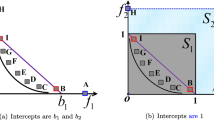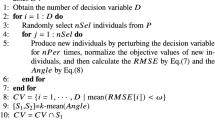Abstract
In recent years, many multi-objective evolutionary algorithms have been proposed to solve many-objective optimization problems with regular Pareto front. These algorithms have shown good performance in balancing convergence and diversity. However, in the high-dimensional objective space, the non-dominated solutions increases exponentially as the number of objectives increases. The metrics to evaluate algorithm performance are also computationally intensive. In particular, solving the many-objective optimization problem of the irregular Pareto front faces great challenges. Moreover, many-objective evolutionary algorithms, do not easily show their convergence and diversity through visualization, as multi-objective evolutionary algorithms do. To address these problems, a many-objective optimization algorithm based on decomposition and hierarchical clustering selection is proposed in this paper. First, a set of uniformly distributed reference vectors divides non-dominanted individuals into different sub-populations, and then candidate solutions are selected based on the aggregation function values in the sub-populations. Second, a set of adaptive reference vectors is used to rank the dominant individuals in the population and retain promising candidate solutions. Third, a hierarchical clustering selection strategy is used to enable solutions with good convergence to be selected. Finally, a diversity maintenance strategy is used to remove solutions with poor diversity. The experimental results show that the proposed algorithm EA-DAH has advantages over other comparative algorithms in many-objective optimization problems with irregular Pareto fronts.











Similar content being viewed by others
Notes
The codes of the IGD and CPF are implemented in [35], available at https://github.com/BIMK/PlatEMO.
References
Lygoe RJ, Cary M, Fleming PJ (2013) A real-world application of a many-objective optimisation complexity reduction process. International Conference on Evolutionary Multi-Criterion Optimization
Reed PM, David H (2014) Evolving many-objective water management to exploit exascale computing. Water Resour Res 50(10):8367–8373
MolinaLopez JM, Herrero JG, Berlanga A (2009) Effective evolutionary algorithms for many-specifications attainment: Application to air traffic control tracking filters. IEEE Trans Evol Comput 13(1):151–168
Fleming PF, Purshouse RC, Lygoe RJ (2005) Many-objective optimization: An engineering design perspective 3410:14–32
Yang S, Li M, Liu X, Zheng J (2013) A grid-based evolutionary algorithm for many-objective optimization. IEEE Trans Evol Comput 17(5):721–736
Ye TXZ, Jin Y (2014) Shift-based density estimation for pareto-based algorithms in many-objective optimization. IEEE Trans Evol Comput 18(3):348–365
Zhang X, Ye T, Jin Y (2015) A knee point driven evolutionary algorithm for many-objective optimization. IEEE Trans Evol Comput 19(6):761–776
Yi X, Zhou Y, Li M, Chen Z (2017) A vector angle-based evolutionary algorithm for unconstrained many-objective optimization. IEEE Trans Evol Comput 21(1):131–152
Bader J, Zitzler E (2011) Hype: An algorithm for fast hypervolume-based many-objective optimization. IEEE Trans Evol Comput 19(1):45–76
Gmez RH, Coello CA (2015) Coello Improved metaheuristic based on the r2 indicator for many-objective optimization, pp 679C686
Zhang Q, Li H (2008) Moea/d: a multiobjective evolutionary algorithm based on decomposition. IEEE Trans Evol Comput 11(6):712–731
Li K, Deb K, Zhang Q, Kwong S (2015) An evolutionary many-objective optimization algorithm based on dominance and decomposition. IEEE Trans Evol Comput 19(5):694–716
Cheng R, Jin Y, Olhofer M, Sendhoff B (2016) A reference vector guided evolutionary algorithm for many-objective optimization. IEEE Trans Evol Comput 20(5):773–791
Deb K, Jain H (2014) An evolutionary many-objective optimization algorithm using reference-point-based nondominated sorting approach, part I: Solving problems with box constraints. IEEE Trans Evol Comput 18(4):577–601
Jiang S, Yang S (2017) A strength pareto evolutionary algorithm based on reference direction for multi-objective and many-objective optimization. IEEE Trans Evol Comput 21(3):329– 346
Ishibuchi H, Tsukamoto N, Nojima Y (2008) Evolutionary many-objective optimization A short review. In 2008 IEEE Congress on Evolutionary Computation (IEEE World Congress on Computational Intelligence), pp 2419–2426
Cai X, Yang Z, Fan Z, Zhang Q (2017) Decomposition-based-sorting and angle-based-selection for evolutionary multiobjective and many-objective optimization. IEEE Trans Cybern 47(9):2824–2837
Xu H, Zeng W, Zhang D, Xiangxiang Z (2019) Moea/hd: a multiobjective evolutionary algorithm based on hierarchical decomposition. IEEE Trans Cybern 49(2):517–526
Denysiuk R, Costa L, Santo IE (2014) Clustering-based selection for evolutionary many-objective optimization. In International Conference on Parallel Problem Solving from Nature
Deb K (2001) Multiobjective optimization using evolutionary algorithms. Wiley, New York
Zhou A, Jin Y, Zhang Q, Sendhoff B, Tsang E (2006) Combining model-based and genetics-based offspring generation for multi-objective optimization using a convergence criterion. In: 2006 IEEE International Conference on Evolutionary Computation, pp 892–899
Li K, Kwong S, Cao J, Li M, Zheng J, Shen R (2012) Achieving balance between proximity and diversity in multi-objective evolutionary algorithm. Inf Sci 182(1):220–242
Ye T, Cheng R, Zhang X, Cheng F, Jin Y (2018) An indicator based multi-objective evolutionary algorithm with reference point adaptation for better versatility. IEEE Trans Evol Comput 22(4):609–622
Wu M, Li K, Kwong S, Zhang Q (2020) Evolutionary many-objective optimization based on adversarial decomposition. IEEE Trans Cybern 50(2):753–764
Sam L, Zhang KQ, Mengyuan W, Zhang J (2019) Learning to decompose: A paradigm forn decomposition-based multiobjective optimization. IEEE Trans Evol Comput 23(3):376–390
Das I, Dennis JE (1996) Normal-boundary intersection: a new method for generating the pareto surface in nonlinear multicriteria optimization problems. Siam J Optim 8(3):631–657
Cheng R, Jin Y, Narukawa K, Sendhoff B (2015) A multiobjective evolutionary algorithm using gaussian processbased inverse modeling. IEEE Trans Evol Comput 19(6):838–856
Dickinson AW (2002) Experiments with mixtures: Designs, models, and the analysis of mixture data. Technometrics 24(2):161–162
Qi Y, Ma X, Liu F, Jiao L, Sun J, Wu J (2014) Moea/d with adaptive weight adjustment. IEEE Trans Evol Comput 22(2):231–264
Agrawal RB, Deb K, Agrawal RB (1994) Simulated binary crossover for continuous search space. Compl Syst 9(3):115–148
Deb K, Goyal M (1996) A combined genetic adaptive search (geneas) for engineering design. Comput Sci Inf 26(4):30–45
Deb K, Thiele L, Laumanns M, Zitzler E (2001) Scalable test problems for evolutionary multiobjective optimization, pp 105–145
Jain H, Deb K (2019) An evolutionary many-objective optimization algorithm using reference point based nondominated sorting approach, part ii: Handling constraints and extending to an adaptive approach. IEEE Trans Evol Comput 18(4):602–622
Deb K (2005) Scalable test problems for evolutionary multiobejctive optimization. Evolutionary Multiobjective Optimization Theoretical Advances & Applications
Tian XZY, Cheng R, Jin Y (2017) Platemo: A matlab platform for evolutionary multiobjective optimization [educational forum]. IEEE Comput Intell Mag 12(4):73–87
Coello CA, Nareli Cruz Corts. (2005) Solving multiobjective optimization problems using an artificial immune system. Coello Genet Programm Evolvable Mach 6(2):163–190
Tian X, Miqing Z, Ye L, Cheng R, Jin Y (2019) Diversity assessment of multi-objective evolutionary algorithms Performance metric and benchmark problems [research frontier]. IEEE Comput Intell Mag 14(3):61–74
He X, Zhou Y, Chen Z, Zhang Q (2019) Evolutionary many-objective optimization based on dynamical decomposition. IEEE Trans Evol Comput 23(3):361–375
Yuan Y, Xu H, Bo W, Bo Z, Yao X (2016) Balancing convergence and diversity in decomposition-based many-objective optimizers. IEEE Trans Evol Comput 20(2):180–198
Durillo JJ, Nebro AJ (2011) jmetal:a java framework for multi-objective optimization. Adv Eng Softw 42(10):760–771
Ishibuchi HMH, Yu S, Nojima Y (2017) Performance of decomposition-based many-objective algorithms strongly depends on pareto front shapes. IEEE Trans Evol Comput 21(2):169–190
Phillips P, Yang J, Sun P, Shuihua Y, Zhang W (2016) Magnetic resonance brain classification by a novel binary particle swarm optimization with mutation and time-varying acceleration coefficients. Biomedizinische Technik Biomedical engineering
Li J, Wu X, Wang H, Liu B, Dong Z, Wang S, Yang M, Zhang Y (2017) Texture analysis method based on fractional fourier entropy and fitness-scaling adaptive genetic algorithm for detecting left-sided and right-sided sensorineural hearing loss. Fund Inf 151(1-4):505–521
Li J, Wu X, Wang H, Liu B, Dong Z, Wang S, Yang M, Zhang Y (2017) Investigating the effect of imbalance between convergence and diversity in evolutionary multi-objective algorithms. IEEE Trans Evol Comput 21(3):408–425
Acknowledgements
This research is partly supported by the Natural Science Foundation of China (Grant No. 11871279 and 61971234), Humanity and Social Science Youth foundation of Ministry of Education of China (Grant No. 12YJCZH179), the Natural Science Foundation of the Jiangsu Higher Education Institutions of China (Grant No. 16KJA110001). Thanks all authors for providing the source codes of the comparison algorithms.
Author information
Authors and Affiliations
Corresponding author
Ethics declarations
Conflict of Interest
The authors declare that they have no conflict of interest.
Additional information
Publisher’s note
Springer Nature remains neutral with regard to jurisdictional claims in published maps and institutional affiliations.
Appendix
Appendix
Rights and permissions
About this article
Cite this article
Sun, Y., Xiao, K., Wang, S. et al. An evolutionary many-objective algorithm based on decomposition and hierarchical clustering selection. Appl Intell 52, 8464–8509 (2022). https://doi.org/10.1007/s10489-021-02669-9
Accepted:
Published:
Issue Date:
DOI: https://doi.org/10.1007/s10489-021-02669-9


























































